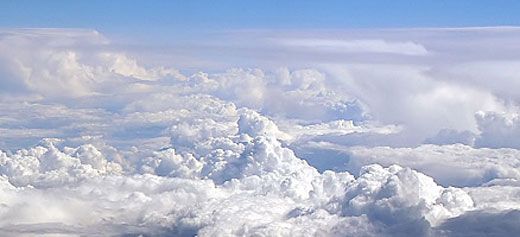
Research from CERN involving University of Leeds scientists provides news insights into cloud formation in the atmosphere.
In a paper published in the journal Nature today, the CLOUD experiment - designed to study the effect of cosmic rays on the formation of atmospheric aerosols under controlled laboratory conditions - reports its first results.
Aerosols are tiny particles suspended in the atmosphere which are thought to be responsible for a large fraction of the seeds that form cloud droplets. Understanding the process of aerosol formation is therefore important for understanding the climate.
The CLOUD results show that trace vapours assumed until now to account for aerosol formation in the lower atmosphere can explain only a tiny fraction of the observed atmospheric aerosol production. The results also show that ionisation from cosmic rays significantly enhances aerosol formation.
Precise measurements such as these are important in achieving a quantitative understanding of cloud formation, and will contribute to a better assessment of the effects of clouds in climate models.
"These new results from CLOUD are important because we've made a number of first observations of some very important atmospheric processes," said the experiment's spokesperson, Jasper Kirkby from CERN.
"We've found that cosmic rays significantly enhance the formation of aerosol particles in the mid troposphere and above. These aerosols can eventually grow into the seeds for clouds. However, we've found that the vapours previously thought to account for all aerosol formation in the lower atmosphere can only account for a small fraction of the observations - even with the enhancement of cosmic rays."
Co-author Professor Ken Carslaw from the University of Leeds, said: "Twenty years of research has told us that the formation of atmospheric particles is important for Earth's climate. Now the CLOUD experiment has given us a unique insight into how the particles form and will completely change our understanding of what's happening in the atmosphere."
Atmospheric aerosols play an important role in the climate. Aerosols reflect sunlight and produce cloud droplets. Additional aerosols would therefore brighten clouds and extend their lifetime.
By current estimates, about half of all cloud droplets begin with the clustering of molecules that are present in the atmosphere only in minute amounts. Some of these embryonic clusters eventually grow large enough to become the seeds for cloud droplets.
Trace sulphuric acid and ammonia vapours are thought to be important, and are used in all atmospheric models, but the mechanism and rate by which they form clusters together with water molecules have remained poorly understood until now.
The CLOUD results show that a few kilometres up in the atmosphere sulphuric acid and water vapour can rapidly form clusters, and that cosmic rays enhance the formation rate by up to ten-fold or more.
However, in the lowest layer of the atmosphere, within about a kilometre of Earth's surface, the CLOUD results show that additional vapours such as ammonia are required.
Crucially, however, the CLOUD results show that sulphuric acid, water and ammonia alone - even with the enhancement of cosmic rays - are not sufficient to explain atmospheric observations of aerosol formation. Additional vapours must therefore be involved, and finding out their identity will be the next step for CLOUD.
"It was a big surprise to find that aerosol formation in the lower atmosphere isn't due to sulphuric acid, water and ammonia alone," said Kirkby. "Now it's vitally important to discover which additional vapours are involved, whether they are largely natural or of human origin, and how they influence clouds. This will be our next job."
The CLOUD (Cosmics Leaving OUtdoor Droplets) experiment consists of a state-of-the-art chamber in which atmospheric conditions can be simulated with high control and precision, including the concentrations of trace vapours that drive aerosol formation. A beam of particles from CERN's Proton Synchrotron accelerator provides an artificial and adjustable source of cosmic radiation.
The experiment is conducted by an international and interdisciplinary collaboration of scientists from Austria (University of Innsbruck, University of Vienna), Finland (Finnish Meteorological Institute, Helsinki Institute of Physics, University of Eastern Finland, University of Helsinki), Germany (Johann Wolfgang Goethe University Frankfurt, Leibniz Institute for Tropospheric Research), Portugal (University of Beira Interior, University of Lisbon), Russia (Lebedev Physical Institute), Switzerland (CERN, Paul Scherrer Institut), the United Kingdom (University of Leeds) and the United States of America (California Institute of Technology).
For more information
Contact CERN Press Office,
T : +41 22 767 34 32 or +41 22 767 34 32
E : press.office@cern.ch
W: http://www.cern.ch/Press
Or
Press Office, University of Leeds
T: +44 (0) 113 343 4031
E: pressoffice@leeds.ac.uk